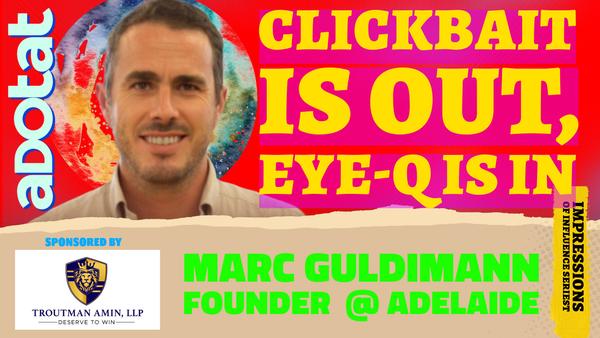Marc Guldimann isn’t your typical ad tech exec. Forget the polished suits and scripted pleasantries; this guy's here to shake things up with a healthy dose of irreverence. As the co-founder and CEO of Adelaide Metrics, Marc introduced the revolutionary Attention Unit (AU) to an industry in dire need of a shake-up. He’s not
just another face in the crowd; he’s a man on a mission to bring trust and transparency back to digital advertising.
Cutting Through the Noise
“How are you really doing?” It’s a question Marc answers with refreshing candor. He's excited about upcoming industry meetups and confident about the future, despite the occasional earthquake in New York. When it comes to swimwear, Marc’s
blunt: “I don't think I'm swimsuit ready at 45.” But who needs a beach body when you're revolutionizing an industry?
Asked which meme he'd be, Marc doesn’t hesitate to reference an 80s montage scene—a nod to the chaotic yet exciting world he thrives in. His path hasn’t been guided by a single mentor but by a chorus of industry legends like Steve Kadelman and Jonah Goodheart, who’ve helped him navigate the turbulent waters of digital advertising.
The Birth of the Attention Unit
You’ve heard of CPM and viewability, right? Toss those relics aside. These metrics have been the industry standard for years, but let’s be honest—they’re like using a flip phone in the age of smartphones. They offer a basic measure of ad performance but fail to capture the full picture of media quality. Enter Marc’s Attention Unit (AU), the new sheriff in
town ready to redefine how we evaluate media.
The AU is not just another metric; it’s a precise, sophisticated measure of media quality designed to reinvigorate trust between buyers and sellers. Think of it as the difference between a rough sketch and a detailed, high-resolution image. While CPM and viewability metrics have been useful to a point, they often fail to inspire confidence because they treat all impressions as equal, ignoring the nuances that affect ad
effectiveness.
Marc’s AU steps in to fill this gap. It evaluates media based on the attention it garners, providing a more accurate reflection of an ad’s true impact. This isn’t just about whether an ad was seen (viewability) or the cost of a thousand impressions (CPM); it’s about understanding the quality and engagement level of each impression. By focusing on attention, AU offers a richer, more granular view of media performance.
What makes AU truly revolutionary is its versatility. It’s not confined to a single type of media; it spans the entire media landscape. From digital out-of-home (DOOH) advertising to online video, cinema, and digital audio, AU can measure it all. This makes it a comprehensive tool for advertisers looking to gauge the effectiveness of their campaigns across various platforms.
In today’s fragmented media environment, where consumers interact with content across
multiple channels, having a metric that can seamlessly adapt to different media types is invaluable. AU’s ability to cover such a broad spectrum means advertisers no longer have to rely on a patchwork of metrics to understand their media quality. They can use AU as a unified standard, bringing consistency and clarity to their media evaluations.
But it’s not just about the numbers. The real power of AU lies in its ability to rebuild the trust that has been eroded by
outdated metrics. When buyers and sellers can trust the metrics they use to measure each other, it leads to more transparent, efficient, and effective transactions. AU is more than just a new badge; it’s a beacon of reliability in an industry that desperately needs it.
Gaining Industry Buy-In
Introducing a new metric wasn’t a walk in the park. Marc had to sell the idea to brand
advertisers first, convincing them of the importance of media quality. Then, it was onto challenger agencies willing to disrupt the status quo. Today, agencies of all shapes and sizes have attention programs, thanks to Marc’s relentless pursuit of change.
Early adopters quickly saw the benefits. Marc recalls a pivotal meeting with Microsoft, where the effectiveness of attention metrics became clear. This wasn't just about making the biggest ad network ever; it was
about understanding and improving media quality across the board. Microsoft’s faith in AU set the stage for Adelaide Metrics’ current success.
Teaming Up with Titans
Partnering with the New York Times is like watching Batman team up with Superman—it's a powerhouse collaboration that’s shaking up the industry. The New York Times has always been a bastion of high-quality journalism,
and now, with Adelaide Metrics' Attention Unit (AU), they're setting new standards for media quality. The Times consistently outperforms benchmarks, making them the ideal partner to showcase the transformative power of AU. This isn’t just about slapping a new metric on their ads; it’s about fundamentally changing how media quality is measured and valued.
For the New York Times, embracing AU is a strategic move to highlight the premium nature of their inventory. In
an era where clickbait and low-quality content often dominate the digital landscape, the Times is leveraging AU to demonstrate that high-quality media deserves a premium price. The AU provides a clear, data-driven way to prove the value of their content to advertisers. By using AU, the New York Times can offer advertisers not just reach, but engaged and attentive audiences, which is the holy grail of effective advertising.
This partnership also signals a broader
shift in the industry. High-quality publishers like the New York Times are no longer willing to compete on price alone; they are demanding that their quality be recognized and compensated accordingly. By adopting AU, the Times is leading the charge toward a more rational and transparent market where media quality is accurately measured and appropriately valued. This collaboration sets a precedent for other publishers to follow, making it clear that the future of media buying will be driven by
quality metrics like AU.
The Future of Media Metrics
So, where’s this all headed? Marc Guldimann isn’t just tinkering around with some fancy new metrics—he’s plotting a revolution. Imagine a future where attention metrics aren’t just a nice-to-have but the backbone of every media transaction. Sounds dreamy, right? Well, Adelaide Metrics’ recent launch of a sell-side product with
the New York Times is the first domino in what Marc envisions as a chain reaction that will reshape the industry. Attention metrics are poised to become the market-wide standard, driving trust, and bringing some much-needed rationality to media pricing. Marc’s goal? To create a functional and transparent marketplace where both buyers and sellers can finally play nice.
But let’s not kid ourselves—this isn’t going to be a cakewalk. The advertising world is
notoriously stuck in its ways, with an almost pathological obsession with cost-cutting and cheap CPMs. It’s been a race to the bottom, and the results? Mediocre at best. Marc’s here to change the narrative, shifting the focus from cost to quality and value. This isn’t about slapping a new label on old practices; it’s about a full-scale overhaul of how brands think about media. He’s ready to turn the industry on its head, one attention unit at a time.
And let's talk
about the uphill battle Marc faces. The biggest challenge is getting the industry to ditch its entrenched, penny-pinching habits. For years, advertisers have been chasing the lowest CPMs like they’re golden tickets, all while ignoring the garbage quality that comes with those bargain basement buys. Marc’s mission? To make quality the new black. It’s not about tiny tweaks; it’s about transforming the very foundation of media valuation. Brands need to wake up and smell the high-quality
coffee—investing in engaging, high-attention media is the key to real, impactful advertising.
This transformation isn’t just a facelift; it’s reconstructive surgery. Marc is calling for a paradigm shift where advertisers rethink their entire media strategy. Forget the old-school metrics that reward sheer volume—reach, frequency, yada yada. It’s time to prioritize genuine engagement and attention. Marc’s on a crusade to educate the market, showing that high-quality
media isn’t just a feel-good investment; it’s a smart business move. The aim is to flip the script and make quality, not quantity, the hero of the story.
Marc’s endgame is as ambitious as it is necessary: a media market that’s functional, transparent, and fair. By championing attention metrics, he’s laying the groundwork for an industry overhaul. Imagine a world where advertisers actually know what they’re paying for and publishers are rewarded for creating
top-notch content. No more smoke and mirrors—just clear, data-driven insights that drive real value. With attention metrics at the helm, the future of media buying and selling looks a whole lot brighter.
Marc’s career is full of surprising twists. From hacking Wi-Fi networks in college to inadvertently entering the advertising world, his journey is a testament to the power of curiosity and adaptability. One of his early
ventures involved creating a web calendar that eventually led to building a successful ad tech company acquired by Flash Talking.
Marc’s approach to leadership is straightforward: hire smart people and get out of their way. He fosters a culture of continuous learning by allowing curiosity to thrive. This philosophy has helped Adelaide Metrics stay ahead of the curve in an ever-evolving industry.
If Marc could send a time-traveling
text to his younger self, it’d be a mix of practical advice and cheeky reminders: “Understand industry incentives better—and buy more Bitcoin.” Marc Guldimann isn’t just riding the digital advertising wave; he’s reshaping it, one attention metric at a time. So keep your eyes peeled; this isn’t the last you’ll hear of AU or Marc’s trailblazing journey in ad tech.















